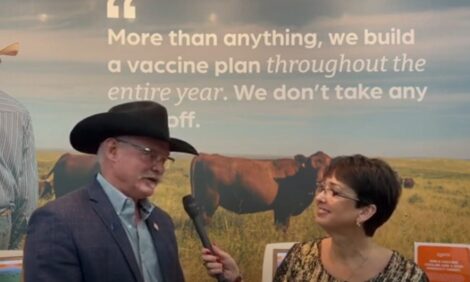



Clinical signs of Foot and Mouth Disease
By Defra, UK - How to detect signs of Foot and Mouth in cattle, pigs and sheep.
Signs of Foot and Mouth in Cattle
- Slobbering and smacking lips.
- Shivering
- Tender and sore feet
- Reduced milk yield
- Sores and blisters on feet
- Raised temperature
Pictures of infected cattle from Defra
Click on the images for a larger version.
All of the above images are Crown Copyright. Information on Crown Copyright and the use of this material is available on Defra website.
The images on this page are taken from the 'Foot and Mouth Disease Ageing of Lesions(1.3 MB - Please note this is a large file) publication which was revised in January 2005.
Signs of Foot and Mouth in Pigs
- Sudden lameness
- Prefers to lie down
- When made to move squeals loudly and hobbles painfully
- Blisters form on the upper edge of the hoof, where the skin and horn meet, and on the heels and in the cleft
- May extend right round the top of the hoof with the result that the horn becomes separated
- Blisters may develop on the snout or on the tongue
See ThePigSite Foot and Mouth Section for more information relating to pigs
Signs of Foot and Mouth in Sheep
Detecting the disease in sheep
As a keeper of sheep you are often the first person who could be suspicious that your animals are affected and so we are providing this further information to assist you during your inspections. The disease can be difficult to recognise in sheep as sometimes as little as 5% of animals in infected flocks show any signs. Look for the following signs:- Sudden death in lambs. In several recent confirmed outbreaks the most obvious sign was apparently healthy lambs dropping dead.
- Abortions
- Lameness (this may only last for a short time)
- Listless and off their food
Inspection of sheep
If you are noticing any of the above signs in your flock then you must inspect individual sheep. Make sure you have plenty of light either daylight or a good torch. For each sheep you must examine both mouth and feet. Do not ask another stock keeper to assist you. If you have any concerns contact your local Animal Health Divisional Office.Mouth
The typical fluid filled blisters are difficult to see as they usually quickly burst. This will leave erosions or ulcers particularly on the dental pad of the upper jaw where the lower front teeth touch the pad. They may also be seen on the gums, lips and tongue and may be very small.Feet
Foot lesions are less common but as the disease progresses they may become more obvious. Transient lameness will be a sign but you must look carefully for blisters, particularly between the claws, on the heel bulbs and the coronary band. Turn back the hair over the coronary band to check for horn separation. If the blisters have burst then hair may be damp and bacterial infection may be present, as could foot rot. Affected feet may feel hot and painful.Defra 2007 - Crown Copyright


















